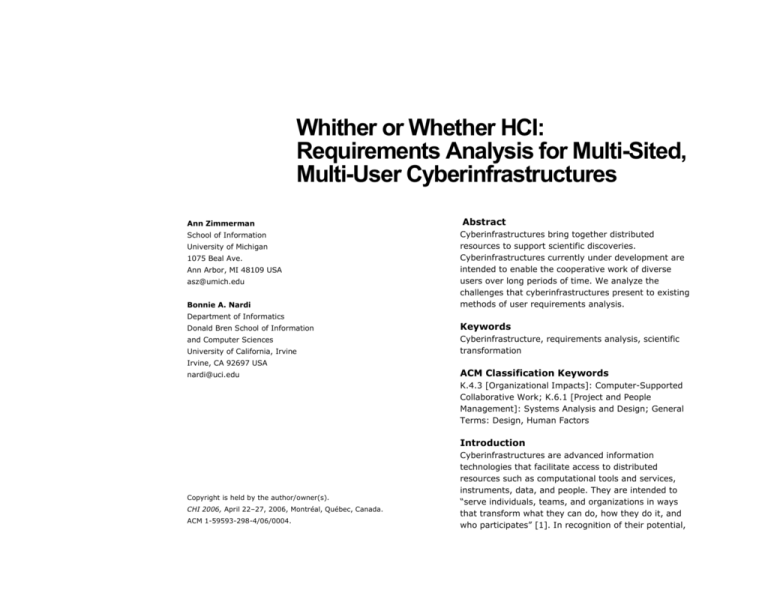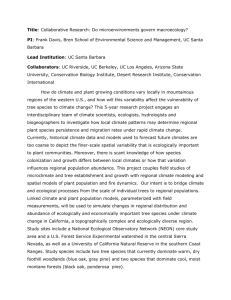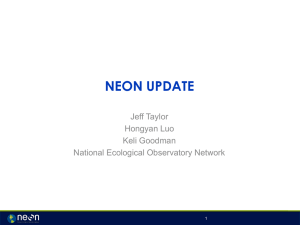Whither or Whether HCI
advertisement

Whither or Whether HCI: Requirements Analysis for Multi-Sited, Multi-User Cyberinfrastructures Ann Zimmerman School of Information University of Michigan 1075 Beal Ave. Ann Arbor, MI 48109 USA asz@umich.edu Bonnie A. Nardi Department of Informatics Abstract Cyberinfrastructures bring together distributed resources to support scientific discoveries. Cyberinfrastructures currently under development are intended to enable the cooperative work of diverse users over long periods of time. We analyze the challenges that cyberinfrastructures present to existing methods of user requirements analysis. Donald Bren School of Information Keywords and Computer Sciences Cyberinfrastructure, requirements analysis, scientific transformation University of California, Irvine Irvine, CA 92697 USA nardi@uci.edu ACM Classification Keywords K.4.3 [Organizational Impacts]: Computer-Supported Collaborative Work; K.6.1 [Project and People Management]: Systems Analysis and Design; General Terms: Design, Human Factors Introduction Copyright is held by the author/owner(s). CHI 2006, April 22–27, 2006, Montréal, Québec, Canada. ACM 1-59593-298-4/06/0004. Cyberinfrastructures are advanced information technologies that facilitate access to distributed resources such as computational tools and services, instruments, data, and people. They are intended to “serve individuals, teams, and organizations in ways that transform what they can do, how they do it, and who participates” [1]. In recognition of their potential, 2 millions of dollars have been spent to support projects to develop cyberinfrastructures with potentially millions more to follow. For example, in its fiscal 2006 budget submission the National Science Foundation (NSF) requested $509 million for targeted investments in cyberinfrastructure [2]. A major challenge for the design of cyberinfrastructures is to support diverse users at multiple sites under conditions of rapid change. There is significant risk that investments in cyberinfrastructures will not be optimized unless this challenge is met. In this paper we discuss what we perceive to be some of the limitations of existing approaches to develop cyberinfrastructures. In particular we found that instability in scientific practice induced by new technology, increases in scale, and rapid rates of change make the application of current user-centered design methods infeasible. We do not yet know of ways to address these shortcomings, but we want to present them to the CHI community to engage a discussion. We have been studying the development of a cyberinfrastructure to support transformational change in the study of ecological processes. The National Ecological Observatory Network, or NEON, is being designed to conduct integrated ecological research through the deployment of a sophisticated instrumentation network distributed across North America. It is believed that a shared, continental-scale platform will enable ecologists to begin to ask and answer much larger scientific questions. NEON is driven by the same factors influencing similar initiatives in other fields. Technological advances, political and social demands, and scientists' desires to address complex problems motivate a move to research that is increasingly collaborative, technology-driven, interdisciplinary, and distributed across space and time. NEON is one of several U.S. environmental observing systems being planned to help predict and solve scientific grand challenges such as those related to climate change, water quality, and infectious diseases. NEON is currently in the planning stages with the hope that it will eventually be supported through the NSF's Major Research Equipment and Facilities Construction (MREFC) account. MREFC funds are used to construct and upgrade equipment and facilities that cost more than several tens of millions of dollars. MREFC funds have traditionally gone to build a single, expensive instrument such as a telescope or particle accelerator. NEON and similar initiatives in the earth and environmental sciences will be different; they will consist of geographically distributed networks of instrumentation, equipment, and facilities [6]. Cyberinfrastructures will be an integral part of NEON and other observatory systems—connecting people to each other, to remote instrument and sensor networks, to data, and to software. In 2005, we were members of a NEON cyberinfrastructure design subcommittee. Although we were asked to participate because of our user-centered perspectives, our experiences on the subcommittee led us to question the adequacy of user-centered design methodologies for grappling with the scale and complexity of NEON. NEON: Facilities, instruments, and cyberinfrastructure for large-scale ecology NEON is more than a specific technology and instrumentation initiative, however. It is intended to be a new way to conduct and organize ecological research. 3 In this vision, ecology will become “big science”—reliant on expensive and sophisticated technology, oriented to broad, problem-directed goals, comprised of multiple institutions and disciplines, and managed through complex structures. NEON represents a major shift in the practice of ecology, which is currently characterized by relatively modest single investigator or small group studies conducted at limited spatial and temporal scales. In order to help ecologists work toward this vision, the NSF provided $6 million for a 21-month planning activity to articulate the scientific questions that will drive NEON, to design the infrastructure that will help to answer those questions, and to create a detailed implementation plan, known as a Project Execution Plan (PEP), for NEON. The PEP is a necessary step on the road to obtaining up to several hundred million dollars from the U.S. Congress, through the NSF, to build NEON. The planning process began in the fall of 2004 and recently passed the halfway mark. The first segment was devoted to an intense effort to involve the larger community in developing the science questions NEON will address and in identifying the instrumentation and infrastructure needed to answer those questions. This process involved 160 individuals, known as the NEON Design Consortium (NDC), who met in a series of three face-to-face meetings in 2005. NDC members were selected from more than 700 applicants who volunteered to participate. Final selections were based on the desire of the NSF and the NEON leadership to provide institutional diversity and a wide variety of expertise in disciplines including biological science, computer science, social science, and education. The NDC was divided into committees and subcommittees covering NEON science, education, facilities and infrastructure, and governance. We served as members of the NDC's Information Technology and Communication Subcommittee (ITCS) (a.k.a. the "Cyberinfrastructure Committee"). The goal of the ITCS was to evaluate existing, emerging, and required cyberinfrastructure for NEON, including technologies to support collaboration, communication, scientific workflow, and the collection, management, and analysis of data. Other members of the 10-person subcommittee were experts in computer science, ecological informatics, or scientific data. The nature of cyberinfrastructure design Our experience on the ITCS led us to reflect on the scientific, political, and social contexts in which NEON is being developed and on the form of user requirements analysis that is appropriate and useful for cyberinfrastructures designed in this and similar contexts. We observed that cyberinfrastructures: must accommodate multiple diverse user populations. involve multiple sites of use. are linked to long-term efforts, e.g., NEON should be viable for 30 years. are large-scale, supporting, for example a whole discipline or very large interdisciplinary groups. are unstable because the practice of the science is being redesigned as the cyberinfrastructure is being designed and deployed. How can user requirements for systems with these characteristics be generated? We know of no scalable 4 methods of requirements analysis that document the needs of vastly different user populations, continue to document changing needs over decades, coordinate investigation at multiple sites of use, design for large distributed entities, and absorb transformative changes in practice. Yet, this is what is required for cyberinfrastructures. Limitations of existing methods Techniques of user-centered design and participatory design, while extremely useful, have been employed largely to design and develop small-scale, standalone systems under conditions of relative stability [5]. They do not scale to the complexity and magnitude of cyberinfrastructures, nor can they keep pace with the speed at which these projects move. We discuss problems of uncertainty, heterogeneity, and rapid rates of change. Uncertainty First and foremost, current methods are not adequate to handle uncertainty. The objectives of user-centered design are to understand users’ interactions with technology and to make visible users’ current practices. In most cases, actual users who are performing real work are studied. But in the context of cyberinfrastructures, there are no real users performing real work to study. The technology is being designed to accommodate new, transformative practice that does not yet exist. With other members of the NEON ITCS, we discussed the need to develop user scenarios. But which ones? Which users doing what work? A fundamental tenet of user-centered design is to consult the users. In the NEON planning process, the users were assembled in congenial face to face settings, yet were unable to answer questions about how NEON should be designed because they did not know what might be possible with the new technologies. This made it difficult for them to answer specific questions posed by the ITCS, such as: What types of search and discovery methods should be available for NEON data, e.g., by observatory, by sensor type, by location, or by time? What types of common tools, applications, and models should be offered in NEON? Scientists were asked to develop science questions based on technologies that will be feasible in five years, but since scientific questions are in part a function of scientists’ abilities to understand what the technology will make possible, the ITCS found itself caught in a paradox in which existing HCI methods provided little guidance to help us in aiding scientists to alleviate this tension. Heterogeneity Not only does the actual work not yet exist, making it difficult to design cyberinfrastructures, even with excellent access to users, but the NEON vision includes a breathtaking mix of diverse users performing many different types of work. Users include sensor engineers, ecologists and related scientists, amateur citizen scientists, educators, and students down to the level of elementary school. NEON is seriously intended to support everyone from Nobel prize winners to children in grade school. Designing for even one of these groups would be complicated and could easily require a significant investment of time and resources. Finholt reported that the collaboratories of the 1990's engaged groups ranging in size from 17-215 [3]. Cyberinfrastructures will serve thousands of diverse users, spanning multiple geographies, disciplines, and 5 cultures. And the problem is not merely additive; interactions between these groups must be planned for. development, and user feedback, followed by another design cycle as in classic iterative design. Uncertainties and heterogeneity are exacerbated by the socio-political aspects of devoting several hundred millions of dollars—a huge sum of money by ecology’s standards—to a technology-focused research program for ecological processes. Even though it is acknowledged by NEON planners that small-scale, individual investigator studies will continue to be important, the concern remains that initiatives such as NEON will drain money from other areas [6]. As the NEON planning process progressed and scientific questions and aspirations were narrowed based on technological feasibility and fiscal realities, it became increasingly clear that NEON could not be all things to all people. Since NEON is being designed to be operational for 30 years, the implications of this realization were sobering. Some ecologists on the NDC were concerned that questions that can be addressed remotely with cuttingedge technologies will be favored over those that are dependent on the deployment of people out in the field. Such issues complicate the work of HCI professionals because existing methods of HCI depend on some degree of agreement and stability within user groups. Ironically, this speedy rate of development will be followed by a lag in which technology, scientific practice, and societal needs will change. Even if Congress opts to fund the design detailed in the NEON PEP that will be delivered in fall of 2006, NEON will not be operational before 2010. How can changes that affect the design of the cyberinfrastructure to support NEON be tracked during this period? Rate of change NEON design activities are moving forward at a dizzying pace. Methods of user-centered design acknowledge that user requirements often change when individuals employ new tools. Thus, many designers advocate iterative methods of design, deployment, and feedback [4, 7]. In NEON, iterative design is hindered by the speed at which the planning process is occurring. There is no time for requirements analysis, prototype Others have observed the limitations of existing methods of user requirements analysis in the design of large-scale information infrastructures. For example, Oostveen and van den Besselaar noted similar problems when they tried to use iterative design and participatory design methods to engage user involvement in the design of a system to support administrative transactions across seven European countries [5]. The authors found that the absence of a functioning prototype for testing made it difficult to use iterative design methods. In addition, participatory design techniques did not scale to complex environments with large numbers of heterogeneous users, exactly as in the case of scientific cyberinfrastructures. Whither or whether HCI? Given the enormity of the challenges presented by cyberinfrastructures, it is reasonable to ask whether HCI professionals can do anything more than usability studies once technologies have been put into place. We prefer to think the answer to whither or whether is whither, and our current research efforts are aimed at discovering methods that will be useful for multi-sited, multi-user cyberinfrastructures. While we have not yet 6 devised new HCI methods, we believe these methods will arise from answering the following questions: 1. What is the appropriate length of time for cyberinfrastructure planning processes, and how can these processes best be structured? 2. How can planning be sustained as needs and conditions change over the course of a decades-long effort? 3. How can the diversity of users be designed for, not just "power users" or putative "ordinary users"? Having answers to these questions in advance of planning will be necessary because once the design process begins it is difficult to alter its course. Just as the HCI community has been successful in changing corporate processes to accommodate user testing, we believe even large and complex cyberinfrastructures can be designed in systematic ways to attain the goals they set for themselves. We see this as a critical challenge for HCI as we seek to scale up our own methods just as scientific initiatives like NEON seek to scale up scientific practice. Our challenge is not only to establish the methods but to once again change organizational practices to accept the methods. Summary A contribution of this paper has been to report our experiences in understanding the operation of the development of a scientific cyberinfrastructure. We have bumped up against the limits of the HCI methods we have been trained in, yet we see a great need for further development of these methods given the stakes of projects such as NEON. Not only do such projects attempt to transform science, they offer the possibility of addressing large societal problems through fruitful use of technology. Finding ways to calm the beasts of uncertainty, heterogeneity, and speed is the way forward to answering whither HCI when designing cyberinfrastructures. Acknowledgements We thank the leaders of the NEON planning effort for including us in the process. Nathan Bos, Tom Finholt, Il-hwan Kim and three anonymous reviewers provided helpful comments on the manuscript. References [1] Atkins, D., et al. Revolutionizing science and engineering through cyberinfrastructure: Report of the National Science Foundation Blue-Ribbon Panel on Cyberinfrastructure. National Science Foundation, Washington, DC, USA, 2003. [2] Executive Office of the President. Budget of the United States Government, Fiscal 2006. Superintendent of Documents, Washington, DC, USA, 2005. [3] Finholt, T. A. Collaboratories. Annual Review of Information Science and Technology 36 (2002), 74107. [4] Olson, G., Finholt, T., and Teasley, S. Behavioral aspects of collaboratories. In S. Koslow and M. Huerta, eds. Electronic collaboration in science. Lawrence Erlbaum, Mahwah, NJ, USA, 2000, 1-14. [5] Oostveen, A. and van den Besselaar, P. From small scale to large scale user participation: A case study of participatory design in e-government systems. In Proc. Part. Design Conf. 2004, ACM Press (2004), 173-182. [6] Senkowsky, S. NEON: Planning for a new frontier in biology. BioScience 53, 5 (2003), 456-461. [7] Shneiderman, B., and Plaisant, C. Designing the user interface: Strategies for effective human-computer interaction (4th ed.). Pearson, Boston, MA, USA, 2005.







